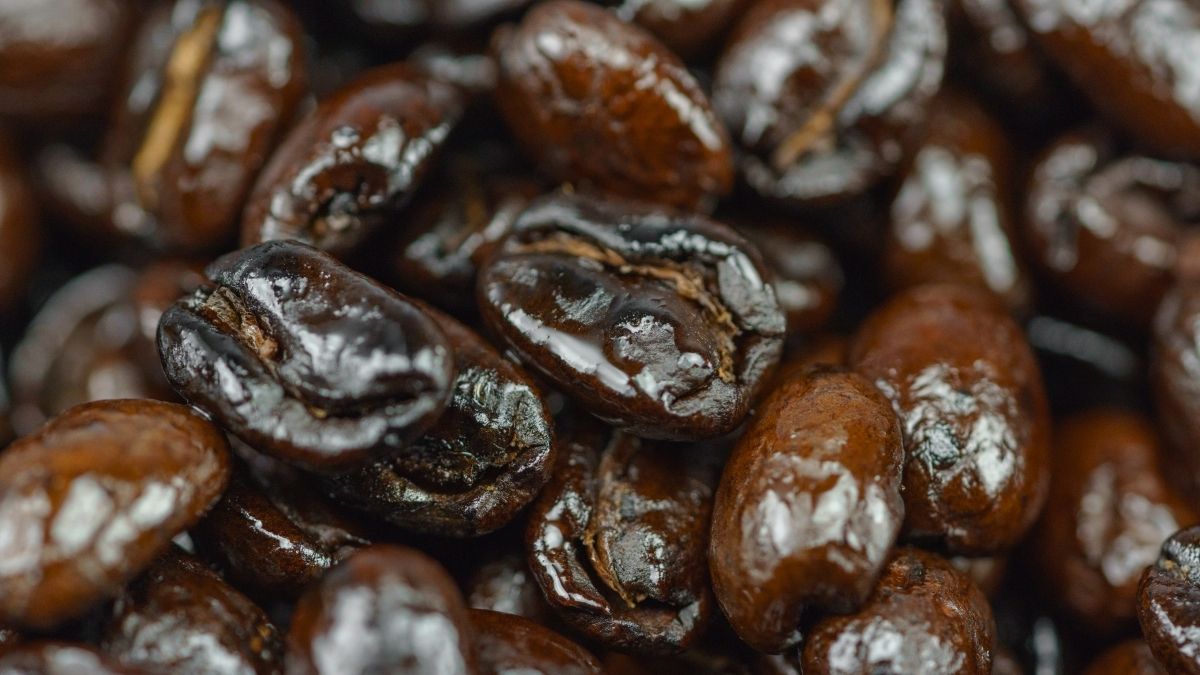There have been several perspectives about the origin and nature of oily coffee beans. All coffee beans have oil, which itself is solid till the coffee cherry is roasted. The cherries are subsequently transformed into coffee beans. When the beans are roasted for much too long, the oils work their way out.
Oily coffee beans can jam your grinder as well as destroy your espresso coffee machine by forcing the coffee grounds to cling around, resulting in a clay-like consistency. Rather than using an automated coffee maker, coffee enthusiasts advocate using a burr grinder for grinding oily beans. Burr grinders assemble easily and thus are convenient to clean.
If you’re still using oily coffee beans on your automated coffee maker, you should stop right now. In this article, we will try to answer all your concerns such as why oily beans are oily, how to consume oily beans properly, and what to do if you’re still using oily beans.
Why Are Some Coffee Beans Oily?
If you’ve already come across oily beans, you’ve probably puzzled why most have a glossy finish whereas others look dry. What is the backstory? Is this a benefit or a glitch?
Oily coffee beans are caused by lipids inside the coffee bean rising to the exterior as oil. This might occur instantly after a long roasting time, or slowly when the beans are preserved after being roasted. The layer of oil on coffee beans does not necessarily suggest that they are of bad quality or just too old, however, it does point to a few things to look at.
Coffee is a nuanced drink, so the solution isn’t simple. You might hear contradictory statements such as “oily beans are well roasted and fresh” and “oily beans are stale and oil.” To establish if the oil is a positive or bad indicator, evaluate how deeply the coffee beans were roasted. If you detect oil on such a medium or light roast, it’s likely that it has been kept for a long time—possibly without even an appropriate container. If you notice this on dark roast coffee beans, then it might be quite new and fresh.
Why Oily Coffee Beans Are Bad For Grinders
The type of coffee beans used is an important factor to take into account, especially when using grinders. Attempting to avoid greasy and flavorful beans can help you keep your coffee machine in good working order.
When you are using oily coffee beans, it’s just a question of how long until the coffee grinder begins to malfunction. Here are some of the common reasons why.
They will clog your grinder
First and foremost, the grinder could get clogged. As a result, the coffee beans would be unevenly ground.
Oily beans are sticky and build a deposit on all elements of your equipment, as well as the grinder. Residual burned oil out from the base of a cooking pot may be difficult to remove and will surely impact the taste of your dish.
The same is true for your coffee maker. Using oily beans on such a regular basis may cause leftover oil to become sticky and adhere to the parts of your coffee maker.
The bean hopper will become sticky
Stickiness is a characteristic of oily materials. The oil upon that surface of the oily coffee beans will cling to various machine parts.
The bean hopper sidewalls are among the machine parts I’m referring to. As a result, the grindings trapped everywhere would prohibit the coffee beans from flowing down within the grinder.
The grinder could collapse
The additional downside of oily coffee beans is that they make it difficult to grind them. That’s because your grinder will continue to spin without pounding the coffee beans. As an outcome, there will be no coffee flowing out from the grinder into the brewing section.
Once it comes to a specific way of operation, high-end devices are equipped with booklets that provide step-by-step instructions. Typically, the procedure begins with adding the coffee beans to the hopper and selecting your chosen setup and grind. You turn on the grinder after you’ve double-checked everything was in place.
How To Unclog The Grinder
If the grinder has been clogged, it must be cleaned. However, ordinary cleaning won’t do it. Brushing the finer teeth of the burrs is beneficial to your equipment, but it will not clear a clog because the impediment is buried within the discharge funnel. Since the grinder is clogged with coffee beans, it must be manually freed of the impediment.
The ideal tool for this is the brush that came with the grinder. The brush’s arm, in particular, may be twisted 45 degrees and used to force compressed coffee out from the discharge funnel.
Don’t fret if you no longer have the brush! Any firm, thin pricking instrument will suffice. A little hex screw such as those sold at IKEA is yet another useful tool for resolving this issue.
The Best Way To Determine If Coffee Beans Are Oily
Once you come across beans with such a shine and a polished look, they indicate oily coffee beans.
Dark roasted and light roasted coffee beans are both popular. These coffee beans are distinguished by their chemical qualities. Furthermore, their varied characteristics cause coffee grinders to react differently to each one of them.
Coffee beans contain a variety of components, including lipids, proteins, and carbohydrates. It usually signifies that all coffee grounds contain oils. Dark roasted coffee beans, on the other hand, are oilier than lightly roasted ones. It’s due to the fact that they contain oil on the surface.
Using a coffee grinder with oily coffee beans would necessitate frequent machine maintenance.
Oily beans are caused by over-roasting or by beans that are too old. Coffee beans are typically roasted at temperatures ranging from about 230 to 260 degrees Celsius.
The surface of the beans gets greasy when they are over-roasted. That’s because the temperature cracks their interior shells. Furthermore, when carbon dioxide inside the shell goes into touch with oxygen, it responds, generating a greasy layer.
How Can You Avoid Using Oily Coffee Beans?
Moisture, light, and heat are the most dangerous players of coffee beans, according to the National Coffee Association USA.
To ensure good storage, they must be maintained in airtight bags in cold environments. This way of storing coffee beans works well for medium and light roasts that grow naturally greasy over time.
Keep a keen eye on the quality of your coffee after you’ve used it. If the texture of the coffee bean is greasy, cease roasting before it becomes brown or black the following time.
Frequently Asked Questions
Is It Possible To Dry Oily Coffee Beans?
You cannot do so. All coffee beans have oil that ultimately leaks out. As a result, the only way to keep the skin from becoming oilier is to ground the coffee beans properly.
What Is The Best Way To Grind Oily Coffee Beans?
When using automated coffee makers, there is a chance that they will break down with time. These malfunction tendencies will need the use of a service facility or to buy new equipment.
As a result, if you enjoy fatty coffee beans, then burr grinders are the way to go. They are easy to maintain because they do not demand considerable disassembly.
How To Remove Coffee Bean Oil From The Filter?
If you are using your coffee maker frequently, the filters as well as other elements of your machine will become greasy. Use aggressive cleaning agents or organic cleaners, such as vinegar and baking soda, in addition to the water.
Coffee Verdict
Oily coffee beans have a distinct look; they are waxy and feel sticky in your hands. You can’t do anything about it because it’s the coffee bean nature. Medium and light roasted coffee should be used if you want to consume fewer oily beans.
Putting oily coffee beans into your grinder is a big no-no since they can jam the grinder as well as other sections of the machine.
Many coffee enthusiasts might regard dark roast coffee as being of poor quality. But, roasting is not really the be-all-end-all; you could monitor the number of beans, ground size, as well as brewing time to produce a delicious cup of coffee.
Numerous prominent coffee shops provide dark roasted oily beans, which have long characterized the iconic coffee aroma. If you prefer to stay with dark roasted coffee beans, make sure you ground them separately and use high-quality coffee beans.


